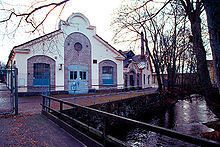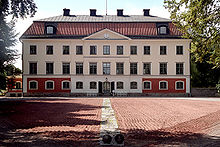Tidaholm
| Tidaholm | ||||
|
||||
| State : | Sweden | |||
| Province (län): | Västra Götalands län | |||
| Historical Province (landskap): | Västergötland | |||
| Municipality : | Tidaholm | |||
| Coordinates : | 58 ° 11 ' N , 13 ° 57' E | |||
| SCB code : | 5460 | |||
| Status: | Crime scene | |||
| Residents : | 8175 (December 31, 2015) | |||
| Area : | 6 km² | |||
| Population density : | 1363 inhabitants / km² | |||
| List of perpetrators in Västra Götaland County | ||||
Tidaholm is a place ( Tatort ) in the Swedish province of Västra Götalands län and the historic province of Västergötland . The place lies between the two lakes Vänern and Vättern and is the main town of the municipality of the same name .
history
Tidaholm is located on the river Tidan on a rapids . At the same time, the river forms two islands, Turbinhusön ("turbine house island") and Vulcanön ("volcanic island"). Certainly since the 16th century there were Vulcanön the settlement Holmagården to a farm estate. After a right to roll iron was granted in 1799, an ironworks with an iron hammer was built there at the beginning of the 19th century . From this Tidaholms bruk developed . In 1846 the professional officer Fredrik Ulrik von Essen (1788–1855) and his son Hans Henrik von Essen (1820–1894) acquired the property on which Tidaholm is today, as well as the ironworks, including the saw and mill . The company grew under Hans Henrik von Essen's leadership. Instead of the blacksmith's shop, a joinery and wagon factory were set up. Windows, furniture and a single-axle horse-drawn cart, known as the Tidaholm cart, based on the British model, which also became an export success to Africa. Hans Henrik von Essen and the wholesaler Charles Bratt were among the initiators of the Vulcan match factory in 1868 ; von Essen initially headed the company.
The early years of the new company were overshadowed by economic difficulties and several severe fires. The first destroyed almost the entire factory on December 10, 1868. It could only start operating in March 1871. The seat was moved to Gothenburg in 1872 and replaced by Essen by George Murray (1844-1911) as managing director. Two more fires followed in 1873; that of April 15 again resulted in a lengthy downtime.
Von Essen and the British businessman James Blackwood set up the Hjo – Stentorp Järnväg in 1873 , which operated the Stenstorp – Hjo railway . This enabled Tildaholmer production to be transported from Fridenes by rail. 1876 the railway reached the narrow gauge - railway Svensbro-Tidaholm the village itself. As early as 1874, von Essen and Blackwood introduced cellulose and paper production in Tidaholm with Sphinz AB . The company was incorporated into Vulcan AB in 1882 . In 1875 there were two more fires to report at Vulcan , with the second on February 18 being counted among the worst fires in Sweden. 46 or 47 people, mostly female employees and children, were killed; this also because of inadequate safety precautions.
Tidaholms bruk were converted into a stock company in 1890. After Hans Henrik von Essen's death, his son Alfred von Essen took over the management of the family business. Around the factories a place that grew up with its economic success and in 1895 originated Market town (Köping) and 1910 for the city was raised.
In Tidaholms Bruk experimented since 1903 with motor vehicles and brought 1907 Commercial Vehicles brand Tidaholm on the market. They were considered progressive and reliable. As one of the initiators of the Tidaholm – Vartofta railway line, which opened in 1906 , Alfred von Essen became chairman of the operating company Tidaholms Järnvägsaktiebolag .
Vulcan had grown rapidly after the disasters and setbacks of the early years, and by 1900 was the largest match factory in the world. The plant produced ammunition during the First World War .
After the merger of the Vulcan plants with Aktiebolaget Förenade Tändsticksfabriker and Jönköpings Tändsticksfabriksaktiebolag , which in 1917 led to Svenska Tändsticks Aktiebolaget (STAB) based in Jönköping , Ivar Kreuger (1880–1832) was in control of the group of companies. In the 1920s, Tidaholms bruks came increasingly under bank control. In 1932 Ivan Kreuger's ignition monopoly collapsed. In the following year, Tidaholms bruks had to declare bankruptcy and give up commercial vehicle construction. The Tidaholm – Vartofta line, which ran to Åsarp from 1907 to 1918 , was nationalized in 1939 and operated by the Swedish State Railways. In 1970 passenger traffic on the route was stopped, and at the end of 1989 also goods traffic. In 1995 the railway was dismantled.
In 1958 a correctional facility with 190 places and a probation service was set up in Tidaholm . With 227 employees, it is one of the larger employers in town. In 1994 she was briefly in the media because of a prison riot.
economy
Tidaholm is still an important industrial city today. Vulcan merged in 1917 with several other match factories to form Svenska Tändsticks AB (STAB) controlled by Ivar Kreuger (1880-1832 ). The company still exists today as Swedish Match Industries AB and operates Sweden's largest match factory in Tidaholm.
Other industrial companies are the kitchen manufacturer Marbodal AB with around 600 employees, Tidamek AB and Lear Corporation Sweden AB. Smaller companies that work as subcontractors for the automotive industry have also settled in Tidaholm .
Cityscape and landmarks
Tidaholm was shaped by the industrial operations, especially the match factory, which was located on the island of Vulcanön . Today there are no more industrial establishments on the islands in the river. The city emerged late, and it was not until 1900 that a city center was built north of the railway line, which no longer exists today. One of the larger buildings from the late 19th century is the library building from 1897; Some of the older wooden houses have also been preserved. The road network and the Ringvägen were laid out in 1924 by the Swedish architect and city planner Albert Lilienberg (1879–1967). The old town hall, built in 1931, is now used as a hotel.
Kavlås manor house
The mansion Kavlås dates back to the 14th century and was in 1750 by the family of food in the Rococo style rebuilt. It is the birthplace of the statesman and Reichsmarschall Hans Henrik von Essen (1755-1824), the Minister and Reichsmarschall Fredrik von Essen (1831-1921) and the entrepreneur Hans Henrik von Essen (1820-1894). The house contains very old frescoes and a portrait gallery.
Helliden Castle
Hans Henrik von Essen had Helliden Castle built as a new residence from 1858–1859 . This house was a social meeting place and received several royal visits. Alfred and Ella von Essen had the manor house expanded in 1895 or 1898 by the architect Helgo Zettervall (1831–1907) and turned into a castle. It came into the possession of the Swedish Blue Cross in 1951 and is now home to a community college and an art lithographic museum.
Local and industrial museum
In addition to the Rudbeck High School , built in 1993, there is a local history, industry and automobile museum on Vulcanön . It was set up in the extensively renovated and adapted former workshop where the machines for making matches were manufactured and repaired. In addition to the former village shop in Varola , several Tidaholm vehicles and a lithographic workshop are on display . An art gallery was set up on Turbinhusön .
sons and daughters of the town
- Hans Henrik von Essen (1755-1824), statesman and Swedish Imperial Marshal (1810-1824)
- Fredrik Ulrik von Essen (1788–1855), major general , inspector of the cavalry
- Hans Henrik von Essen (1820–1894), entrepreneur
- Fredrik von Essen (1831–1921), Swedish member of the Reichstag , Minister of Finance (1888–1894) and Reichsmarschall (1894–1911)
literature
- Ann-Britt Boman: Tidaholm - en tidig industriort. Published in Västgöta Bygden, Tidskrift för hembygdsarbete, natur- och Kulturminnesvård utgiven av Västergötlands Hembygdsförbund , 67th year, No. 2/2012. (Swedish; magazine for homework, nature protection and heritage conservation, published by Västergötland Hembygdsförbund)
- Ann-Britt Boman: ”Tidaholmarn” -ett begrepp i svensk bilhistoria. Published in Västgöta Bygden, Tidskrift för hembygdsarbete, natur- och Kulturminnesvård utgiven av Västergötlands Hembygdsförbund , 67th year, No. 2/2012. (Swedish; magazine for homework, nature protection and heritage conservation, published by Västergötland Hembygdsförbund)
- George Nick Georgano (Ed.), G. Marshall Naul: Complete Encyclopedia of Commercial Vehicles. MBI Motor Books International, Osceola WI, 1979, ISBN 0-87341-024-6 . (English)
Web links
- Riksarkivet / Svenskt biografiskt lexikon (SBL): Hans Henrik von Essen (1820–1894). (Swedish)
- Riksarkivet / Svenskt biografiskt lexikon (SBL): Fredrik von Essen (1831–1921). (Swedish)
- Volkshochschule Helliden. (Swedish)
- Tidaholm Tourism: Helliden Castle. ( Memento from August 20, 2010 in the Internet Archive ) (Swedish)
Individual evidence
- ↑ a b Statistiska centralbyrån : Land area per Tatort, folkmängd and invånare per square kilometer. Vart femte år 1960 - 2015 (database query)
- ^ A b c Svenskt biografiskt lexikon (SBL): Hans Henrik von Essen (1820-1894).
- ↑ a b c d e Boman: Tidaholm - en tidig industriort. Västgöta Bygden 2/2012, p. 5.
- ↑ a b c d e f g Boman: Tidaholm - en tidig industriort. Västgöta Bygden 2/2012, p. 6.
- ↑ a b Georgano, Naul: Complete Encyclopedia of Commercial Vehicles. 1979, p. 618.
- ↑ a b Boman: Tidaholm - en tidig industriort. Västgöta Bygden 2/2012, p. 7.
- ↑ a b c Tidaholm Tourism: Helliden Castle.
- ↑ Helliden Adult Education Center.
- ^ Svenskt biografiskt lexikon (SBL): Fredrik von Essen (1831–1921).





